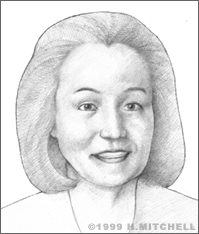Sookie Bang
Sookie Bang invented a process that induces bacteria to create a natural, environmentally friendly cement that can be used to repair faults in rock and concrete from the inside out.
Sookie S. Bang was born and raised in South Korea. She graduated from Seoul National University in 1974 where she specialized in Biology, Chemistry, and Chemical Engineering, earning a BS and MS. She came to the United States and continued her graduate studies at the University of California at Davis in 1981, where she received a PhD in Microbiology. She is now a Professor of Microbiology at the South Dakota School of Mines and Technology.
Bang’s specialty is Bioremediation, that is, simply stated, using biology to fix things that are broken in the environment. Specifically, for some years now Bang has been working with graduate student advisees to perfect a process of “selective microbial plugging.”
Many types of bacteria are efficient at extracting the nitrogen they require to live from urea (the nitrogenous component of urine, produced by many microorganisms). The process produces carbon dioxide and ammonia as byproducts. If water is also present, that ammonia will react with it to form ammonium hydroxide; if calcium is also present, that ammonium hydroxide will react with it to form crystals of calcium carbonate. Calcium carbonate (CaCO3) is better known as limestone.
What Bang and her research teams have done in the lab is to speed up this chain reaction, which occurs in nature very slowly. They mix two common types of soil bacteria, Bacillus pasteurii and Sporosarcina ureae, with sand and “feed” the bacteria a rich solution containing both urea and calcium chloride. After using up the supply of nutrients, the bacteria die, but by that time, the calcium carbonate has crystalized the sand into solid limestone.

Bang’s initial experiments were done in test tubes, but she has now succeeded in “growing” limestone directly within cracks in concrete blocks. Bang’s bacterial cement has many advantages over other methods of sealing faults in concrete: it is pollution-free and environmentally friendly, it seals from the inside out (from the bottom to the top), and it integrates with the porous concrete rather than simply filling the space in the crack.
There is no doubt that Bang’s basic process works. She and her graduate students are perfecting the process, finding the best nutrient solution, concentration of bacteria, and method of delivery. When they are ready to conduct more large-scale experiments, there will be no lack of subjects.
For example, the foundations and outer walls of older skyscrapers like the Empire State Building are devastated by cracks and fractures. These have to be repaired and rigged constantly, by metal bolts, concrete, silicone sealer, and other ad hoc methods. Another monumental candidate for Bang’s sealer is Mount Rushmore, located not far from Bang’s school, which when seen close-up betrays the severe effects of rain and snow, wind, heat, and cold.
To these and more modest construction repair problems, Sookie Bang’s bacterial cement may soon provide a safe, efficient, and permanent solution.


